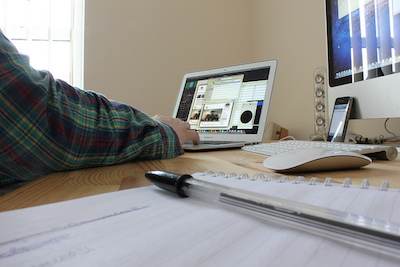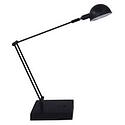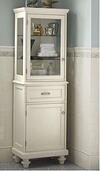Explore Springs Apartments


Whether you work from home infrequently or it’s where you earn your living, a dedicated and organized (or “organizable”) space is key to efficiency and performance. We’ve put together some tips that will help you work at home more comfortably and maximize your productivity.
Basic Needs for Your Home Office
A comfortable chair. Just about any flat surface can serve as a desk (see below), but if you’re not comfortable in your chair, your work – and back – will suffer. Choose a padded chair with a seat that swivels to make it easier to reach your equipment and supplies; the chair should be on rollers so you can maneuver around your space without standing up. A hard-backed, stationary dining chair will do in a pinch, but it will make long hours in front of the computer feel like an eternity.
According to the Einstein School of Medicine at Yeshiva University, these modifications to your posture and computer can help you avoid back, wrist and eye strain:
The right-sized desk. We’ve seen DIY desks made out of everything from old doors and vintage flooring to upcycled road signs (find some great ideas, here). Whatever you select to act as your work surface, according to the Occupational Safety & Health Administration (OSHA), “A well-designed and appropriately-adjusted desk will provide adequate clearance for your legs, allow proper placement of computer components and accessories, and minimize awkward postures and exertions.” Here are some additional tips:
Good lighting. Overhead lights will provide your basic lighting needs, but you’ll also need the more focused light of a table lamp. Choose one with a flexible or articulated neck so you can position it exactly where you need illumination. The one below is from Target and priced around $40.
Wrist rest. The most common job-related repetitive trauma disorders (RSD) involve injury to the upper extremities (wrists, elbows, and hands) due to repetitive keyboard activities like typing. You can relieve some of the stresses involved in using the computer – and perhaps avoid carpal tunnel syndrome – by using a mousepad that features a built-in wrist rest; you can also buy wrist rests for use with your keyboard when you’re typing.
Supplies. To avoid taking time to run out to get supplies when you run out, keep a stash of things you need in a closet or cupboard. Paper (sheets and pads), printer ink, pens, markers, sticky note pads, highlighters, file folders, labels, sealing tape, staples, and binder clips are some of the most commonly used and replenished supplies, according to Staples.
Smart storage. If your home office doesn’t have enough space for a storage cabinet or bookshelf, there are still a number of options for keeping the tools of your trade within reach.

If you’re a Springs Apartments resident who works from home, you probably have some great ideas for optimizing space and making the most of your time. We welcome your insights and encourage you to share your tips!
These Stories on Apartment Living
Take Comfort In Being Home
262-502-5500
We Your Pets
Privacy Policy | Cookie Policy | Terms of Use | Accessibility Statement
Owned and managed by Continental Properties, an award-winning corporate leader and developer of apartment communities nationwide. Copyright © 2025 Springs Apartments